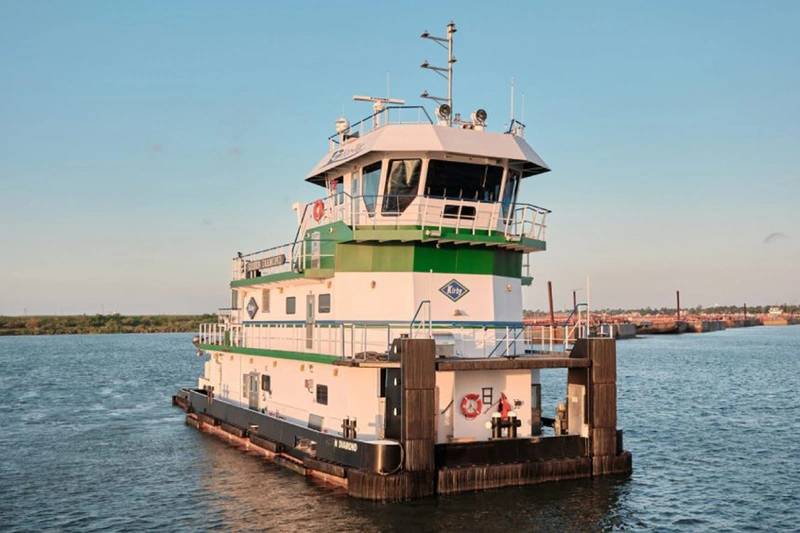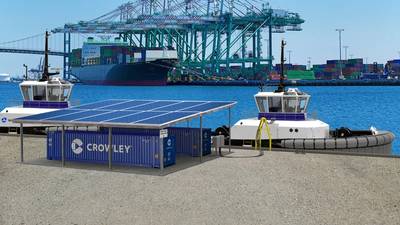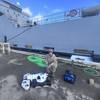Workboat Power: Alternatives Join Diesel to Power Current—and Future—Vessels
Analysts and commentators are quick to point out that fossil fuels will power maritime equipment, and indeed dominate the fueling marketplace, well into the future. However, they will do so alongside new fuels, and new technologies, that will be introduced to the maritime sector in the coming years. In its September, 2023 report “Beyond the Horizon: View of the Emerging Energy Value Chains”, the American Bureau of Shipping (ABS) explains that, “During the recent 80th meeting of the Marine Environment Protection Committee (MEPC 80), International Maritime Organization (IMO) members agreed on the revision of the Initial Strategy and approved the 2023 Strategy which prescribes more enhanced targets to tackle harmful emissions with the continued goal to reach net-zero GHG emissions by (or around) 2050.” While many initiatives are underway, there is no definitive decarbonization path.
The U.S. Environmental Protection Administration (EPA), which participates in the United States delegation to the IMO, notes, “The international standards apply to both U.S. vessels and to foreign vessels Engines installed on U.S. vessels are also subject to fuel standards and engine emission standards that EPA has adopted under the Clean Air Act.”
“Fuels and Propulsion Systems”, a 2022 report by the Blue Sky Maritime Coalition (BSMC, promoting decarbonization for fleets serving North America—many of which are not subject to specific IMO decarbonization measures such as the Carbon Intensity Index, or CII), stressed that “due to significant inherent differences in vessel categories and their operating conditions, there is no ‘one-size-fits-all’ approach to future low- and zero-carbon marine fuels.” At the SHIPPINGInsight 2023 Conference, held in mid-October, Jennifer States, the VP and chief strategy officer of the BSMC, pointed to efforts in aviation, where carriers and government set a goal of creating one fuel for the industry. States, with a background that includes work at Class society DNV, noted that “The industry is working with government to help direct the research, development and deployment that’s needed for sustainable aviation fuel [in an effort dubbed ‘Grand Challenge’]…I would say we need a sustainable maritime fuel.”
 “We need a sustainable maritime fuel.” - Jennifer States, VP and chief strategy officer, Blue Sky Maritime Coalition (Photo: Blue Sky Maritime Coalition)
“We need a sustainable maritime fuel.” - Jennifer States, VP and chief strategy officer, Blue Sky Maritime Coalition (Photo: Blue Sky Maritime Coalition)
EPA Tier 4
In the absence of a grand plan, the course will continue to be charted by rules and regulations. The movement to EPA Tier 4 engines had been slowed as manufacturers struggled to produce engines meeting EPA rules, promulgating further reductions of NOx and particulate emissions. Tier 4 plant technology is typically accomplished using a selective catalytic reduction (SCR) after-treatment to pull out NOx, or, alternatively, exhaust gas recirculation (EGR).
Recent deliveries of Tier 4 vessels have included McAllister Towing’s Jane McAllister, a Washburn & Doughty-built tractor tug powered by a pair of Caterpillar 3516E engines (using the SCR process) that will be handling ship assists in the Norfolk, Va. Crowley Maritime recently took delivery under long-term charters of a trio of Tier 4 tugs, which will be serving the West Coast. The boats use a design from Vancouver, B.C.’s Robert Allan Ltd., and were built at Diversified Marine in Portland, Ore. for Brusco Tug, which then delivered them to Crowley. Summer 2023 saw the delivery of Artemis to Crowley, which will use the vessel (powered by a pair of Caterpillar 3156Es, putting out 7,000 hp) for ship assist and escort work. Earlier, sister vessels Athena, Apollo and Hercules had been delivered to Crowley under similar arrangements, and the vessels ate operating under long term charters.
Suderman & Young Towing, based in Houston, has also taken delivery of several Z-Drive tugs operating in Texas ports. The Eva, Brizo and Aurora are based on the Rapport 2600 design from Robert Allan Ltd., and built by Master Boat Builders Inc. in Coden, Ala. The tugs also are powered by a pair of Cat 3512E’s, each rated at 2,213 bhp, driving a Schottel SRP 430FP Z-drive unit. The same yard has two tugs under construction for Moran Towing; also with a Robert Allan design, set for 2025 delivery. Most recently, Gulf LNG Tugs (a tie-up of Bay-Houston, Suderman & Young, and Moran Towing, announced that it would be ordering a quartet of Robert Allan designed escort tugs with Z-Drives and Cat Tier 4 3516e propulsion- two each from Master Boat Builders and two from the Sterling yard, in Port Neches, Texas.
The public sector is also moving to Tier 4 boats. In Summer, 2023, the Tennessee Valley Authority (TVA, which moves powerplant components by barge) took delivery of Freedom, a towboat built at the Vessel Repair yard in Port Arthur and powered by a pair of Tier 4 certified Caterpillar 3512E engines.
Alternatives to traditional diesel
Hybrid propulsion, where multiple drivers provide the power to turn the propeller, are also playing a role. In 2022, Master Boat Builders had delivered two ship escort tugs with a Robert Allan Ltd. design, Spartan and Titan, to Seabulk Towing. The vessels, with Berg Z Drive azimuth thrusters, can operate on either Tier 4 certified engines (2 x Cat 3512E) or on diesel generators (also from Caterpillar). The Lake Charles and Port Arthur operations of Seabulk Towing, where the two vessels have been operating, will be sold to Bay Houston Towing, in a deal expected to close in late 2023.
 Seabulk’s first ever electric-hybrid tugboat, Spartan, was built by Master Boat Builders and delivered in 2022. (Photo: Master Boat Builders)
Seabulk’s first ever electric-hybrid tugboat, Spartan, was built by Master Boat Builders and delivered in 2022. (Photo: Master Boat Builders)
Electrification will be playing a big role in decarbonization. Kirby Corporation, a leading participant in the U.S. maritime sector, discussing its efforts, has said that: “Testing out alternative fuels, finding operational efficiencies, and investing in new technologies are a few initiatives the company is exploring to accomplish its [sustainability] targets” with a focus on “a 40% reduction of carbon emissions per barrel of capacity by 2040”. In late August, Kirby christened its Green Diamond, which it described as “…the nation’s first plug-in hybrid electric inland towing vessel,” with battery power capability.
Kirby’s Green Diamond is on time charter to a Shell USA subsidiary, operating locally in the Houston area. Another Shell entity, Shell Energy Solutions, installed a plug-in charging station utilizing kit from Zinus- well known for providing shore power in the passenger sector, at Kirby’s Old River Fleet Dock, in Channelview, where the towboat is based. Kirby’s role goes beyond vessel operating. The vessel was built in Channelview by San Jac Marine, LLC, a Kirby-owned shipyard; and Stewart & Stevenson, another Kirby company, was responsible for the design and installation of the power management, control and propulsion systems. The actual propulsion is provided by a pair of 575 kW Danfoss motors, powered by a Corvus Orca series battery array providing 1243 kWh of power, or, if needed, a set of onboard Caterpillar generators.
“According to Kirby’s modeling, when operating on shore supplied power, the fuel use can be reduced by almost 80%, resulting in an estimated 88-95% reduction in emissions of nitrous oxides, carbon monoxide and hydrocarbons,” Kirby said. “When in hybrid mode with the generators running, the boat is expected to have an estimated 27% reduction in emissions compared to a conventional towing vessel.”
Electrification through battery power works best for vessels not deployed continuously, to enable sufficient time for charging. Another BSMC publication, prepared by Vanderbilt University’s Climate Change Initiative, “Pathways to Net-Zero 2050 in the North American Marine Shipping Industry”, explained that “Some vessels, such as harbor assist vessels, operate for very short durations and remain in close proximity to port infrastructure when they are not working. Thus, these vessels may be candidates for electrification because they are frequently waiting at port where they could charge between assisting ocean-vessels into port.”
Crowley is building a fully electric tug, Sea Wolf, for work around San Diego harbor. The battery powered boat (6 Mwh overall, two Corvus Orca BOBs—the containerized version the Corvus Orca, for energy storage), will use an onboard electrical package from ABB. Delivery, from Master Boat Builders, is anticipated in early 2024.
For longer runs on inland rivers, fuel cells are gaining traction for electricity production. The BSMC/ Vanderbilt report noted, “Longer term (15+ years) we expect the emerging investments being made today in hydrogen fuel technology to substantially transform the marine fuel landscape…” For the near term, electricity generated from hydrogen fuel cells is being explored, using methanol and ammonia as “carriers” for the hydrogen. Vessel owner Maritime Partners has invested in e1 Marine, building an electricity powered boat (with methanol input to the fuel cell) to be operated on the inland waterways by American Commercial Barge Line (ACBL).
In a project that will demonstrate the feasibility of ammonia for providing electricity, Amogy, based along the Brooklyn, N.Y. waterfront, is now fitting out a retired tugboat for a demonstration project along the Hudson River. Amogy’s ammonia powerpack—an ammonia fed fuel cell, mountable in a container or on a skid—has seen successful trials powering tractors and trucks. At the SHIPPINGInsight event, Amogy’s manager of strategy and business development, Gancheng Sun, stressed in her remarks that ammonia is widely available and traded with a well-developed infrastructure. Fellow panelist Captain Don Carroll, from chemical tanker owner MT Maritime, sought to dispel issues related to safe handling of ammonia, saying, “We handle it all time; we are very familiar with it.”
Nuclear power is also a potential future fuel for zero emission shipping. On the SHIPPINGInsight fuels panel, Meg Dowling, the nuclear programs lead at ABS, talked about ongoing efforts to evaluate feasibility of reactors for vessels. She suggested that “micro-reactors” putting out equivalent of up to 10 mWe electricity could be used on smaller vessels. A recent release from Crowley announced its cooperation with BWX Technologies—which provides reactors for U.S. military vessels and has recently been evaluating micro-reactors fitted in containers—on a conceptual design for a vessel with an onboard reactor to supply power to shoreside facilities. Core Power, a developer of Molten Salt Reactors (MSR) specifically for the maritime sectors, has been involved in successful testing alongside utility Southern Company, Terra Power, a business incubator tied to Bill Gates.
 Kirby's new plug-in hybrid electric inland towing vessel Green Diamond will be time chartered by Shell Trading (US) Company, which will use the vessel to push barges throughout the Houston port region. According to Kirby, the vessel can achieve an estimated 80% reduction in fuel use and related emissions. (Photo: Kirby Corporation)
Kirby's new plug-in hybrid electric inland towing vessel Green Diamond will be time chartered by Shell Trading (US) Company, which will use the vessel to push barges throughout the Houston port region. According to Kirby, the vessel can achieve an estimated 80% reduction in fuel use and related emissions. (Photo: Kirby Corporation)
California’s push for ‘green’
Alex Parker, managing partner at Rose Cay Maritime, which currently operates a large tug and barge fleet, deployed primarily in the U.S. Gulf and along the East Coast, told Marine News, “We now serve the U.S. West Coast and are consistently transiting the Panama Canal carrying renewable fuels. In our planning, we are monitoring the California Air Resources Board guidelines; as some of our vessels are equipped with Tier 4 engines, including the 4,000 HP Susan Rose built in 2019.”
The California Air Resources Board (CARB) has implemented several regulations to reduce emissions from both oceangoing vessels and harbor craft, and they’re not about fuels of the future; they’re about the here and now. The regulations in California, which have begun to phase-in, may ultimately impose standards even tighter than the EPA’s Tier 4.
Against the considerable hoopla surrounding new fuels, and demonstration projects, internal combustion engines are alive and well. In the international deepsea realm, methanol fueling for conventional engines has been gaining traction, notably with orders for large containerships by giants like Maersk and CMA CGM. Methanol may soon figure into larger vessels in the Jones Act landscape; Overseas Shipholding Group (OSG) recently announced the purchase of the laid-up tanker Alaskan Frontier, which will see extensive engine refurbishments including “[preparing] the engines for possible methanol fuel in the future.”













